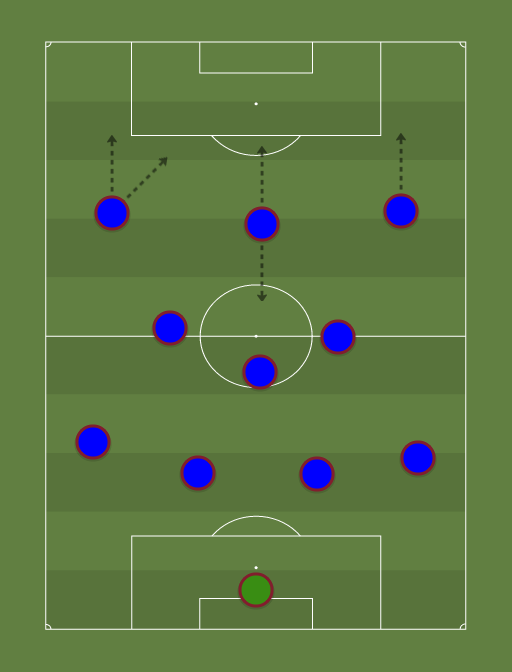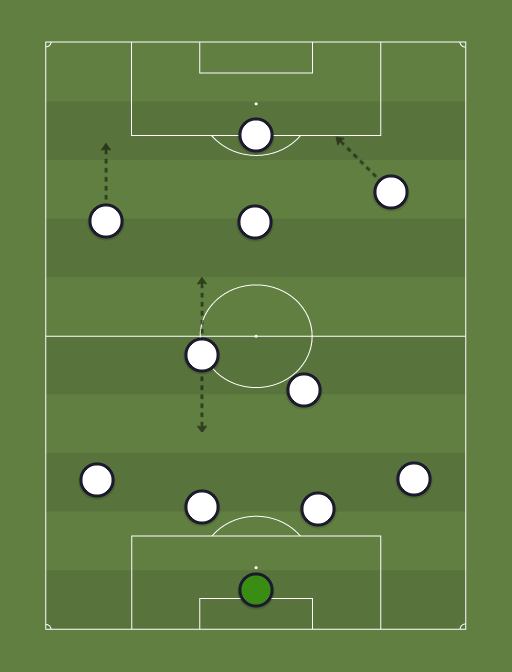Pat_Mustard
I'm so gorgeous they want to put me under arrest!
BIG DUNK:

MICHAEL:

BIG DUNK'S TACTICS:
4-3-3 formation, maintaining an excellent balance of artistry and system. Team philosophy: movement and space. Stretching our opponent when we attack, and we are compact when defending.
Our new front three consists of Mbappé (the best modern 'wingforward'), Messi (the greatest 'false 9') and Garrincha (the greatest dribbling 'winger'), who can score, dribble and create for eachother. Their intelligent movement, vision, tactical intelligence and ability to beat multiple opponents/one vs one is unrivalled. All can create space for their teammates and cut-in from the wing. Our attack is both effective on the counter or against a deep defensive block.
Our midfield comprises three multi-functional footballers. Their all-round skillset and versatility makes them efficient and pro-active in all spaces: deep-lying playmaking, high stamina box-to-box coverage, defensive workrate, connecting fast attacking transitions (vertically and horizontally) and supporting our forwards/fullbacks. Lampard will make late attacking runs, while also and being a threat from long-range.
At left back, the majestic Nílton Santos (33+) is arguably still in his peak here, with Lee Dixon on the other flank: a symbol of consistency and expert positional sense, strengthening the back four. The Stam-Kohler centreback partnership represents an elite mix of physical dominance, intelligent position, elite man-marking and defensive steel. Two of the finest stoppers to ever play the game. In goal, sweeper-keeper Van Der Sar commands his area, another figure exuding composure, positional intelligence and consistency.
Player roles & special instructions:
Van der Sar (sweeper-keeper) - distribute to back four, or quick long throws to Mbappe/Garrincha
Stam (complete centreback) - support Dixon and Kohler.
Kohler (stopper) - man-mark Romario
Dixon (defensive right back) - offensively more reserved than Nílton Santos. Cover Stam.
Nílton Santos (playmaking left back) - passing link up with Lampard and Mbappé. Cover Kohler.
Reyna (deep-lying playmaker) - marking duties: Deyna. Support fullbacks. Vertical direct passes to Mbappé/Garrincha
Essien (box-to-box dynamo) - marking duties: Matthaus. Support fullbacks.
Lampard (box-to-box playmaker) - penetrate space that Messi creates. Support Reyna/Essien in defensive transitions.
Garrincha (right winger) - target Carboni one-vs-one. Create for Mbappé/Messi/Lampard (late runs)
Messi (false 9) - drop deep to create space for Lampard/Mbappé. Switch play horizontally to flanks to Mbappé/Garrincha
Mbappé (left wingforward) - exploit space behind Lahm. Cut into box.
MICHAEL'S TACTICS
My team will play a 4-2-3-1 formation with Heynckes as an inside forward from the right and Littbarski as a winger on the left. I will now detail some of the less well known members of my team before discussing some of the strengths of my team/advantages that I feel my team has in this match.
My left back is the 33+ version of Amedeo Carboni which covers most of his Valencia spell (barring the 1st season) during which time he reached two champions league finals; won two La Liga's, a Copa del Rey, and a UEFA Cup; and was included as part of the IFFHS World Team of the Year in 2004 (when he was 39 years old).
My attacking midfielder is Kazimierz Deyna who finished 6th in the Ballon d'Or in 1972 and 1973 and 3rd in the Ballon d'Or in 1974 (behind Beckenbauer and Cruyff). At the 1974 World Cup he created the second most chances of anyone at a single world cup from 1966 onwards with 30 in 7 games (behind only Cruyff in 1974 and level with Xavi in 2010 although Xavi played slightly more minutes although of the top 10 Pele in 1970 and Hassler in 1994 also created chances more frequently although they played less matches than Deyna in 1974). After the 1974 World Cup, top clubs including AC Milan, Bayern Munich, Inter Milan, Monaco, Real Madrid and Saint Etienne tried to sign Deyna although this did not happen as Deyna was an officer in the Polish army and was thus not allowed to move to a NATO country (although he was eventually able to sign for Manchester City in 1978). Deyna was also a capable goal scorer winning the golden boot at the 1972 Olympics (which were won by Poland) and scoring 41 goals in 97 games for Poland and 141 goals in 389 games for Legia Warsaw.
My left sided centre back is Valery Voronin who is more commonly used in draft games as a central or defensive midfielder but he could also play very well as a central defender as I will now illustrate with some quotes about a couple of his performances at CB during the 1966 World Cup, firstly against Hungary in the Quarter Final and then against Portugal in the 3rd place play off.
vs. Hungary
Link
Link
Link
vs. Portugal
Link
Link
Strengths/Advantages

MICHAEL:

BIG DUNK'S TACTICS:
4-3-3 formation, maintaining an excellent balance of artistry and system. Team philosophy: movement and space. Stretching our opponent when we attack, and we are compact when defending.
Our new front three consists of Mbappé (the best modern 'wingforward'), Messi (the greatest 'false 9') and Garrincha (the greatest dribbling 'winger'), who can score, dribble and create for eachother. Their intelligent movement, vision, tactical intelligence and ability to beat multiple opponents/one vs one is unrivalled. All can create space for their teammates and cut-in from the wing. Our attack is both effective on the counter or against a deep defensive block.
Our midfield comprises three multi-functional footballers. Their all-round skillset and versatility makes them efficient and pro-active in all spaces: deep-lying playmaking, high stamina box-to-box coverage, defensive workrate, connecting fast attacking transitions (vertically and horizontally) and supporting our forwards/fullbacks. Lampard will make late attacking runs, while also and being a threat from long-range.
At left back, the majestic Nílton Santos (33+) is arguably still in his peak here, with Lee Dixon on the other flank: a symbol of consistency and expert positional sense, strengthening the back four. The Stam-Kohler centreback partnership represents an elite mix of physical dominance, intelligent position, elite man-marking and defensive steel. Two of the finest stoppers to ever play the game. In goal, sweeper-keeper Van Der Sar commands his area, another figure exuding composure, positional intelligence and consistency.
Player roles & special instructions:
Van der Sar (sweeper-keeper) - distribute to back four, or quick long throws to Mbappe/Garrincha
Stam (complete centreback) - support Dixon and Kohler.
Kohler (stopper) - man-mark Romario
Dixon (defensive right back) - offensively more reserved than Nílton Santos. Cover Stam.
Nílton Santos (playmaking left back) - passing link up with Lampard and Mbappé. Cover Kohler.
Reyna (deep-lying playmaker) - marking duties: Deyna. Support fullbacks. Vertical direct passes to Mbappé/Garrincha
Essien (box-to-box dynamo) - marking duties: Matthaus. Support fullbacks.
Lampard (box-to-box playmaker) - penetrate space that Messi creates. Support Reyna/Essien in defensive transitions.
Garrincha (right winger) - target Carboni one-vs-one. Create for Mbappé/Messi/Lampard (late runs)
Messi (false 9) - drop deep to create space for Lampard/Mbappé. Switch play horizontally to flanks to Mbappé/Garrincha
Mbappé (left wingforward) - exploit space behind Lahm. Cut into box.
MICHAEL'S TACTICS
My team will play a 4-2-3-1 formation with Heynckes as an inside forward from the right and Littbarski as a winger on the left. I will now detail some of the less well known members of my team before discussing some of the strengths of my team/advantages that I feel my team has in this match.
My left back is the 33+ version of Amedeo Carboni which covers most of his Valencia spell (barring the 1st season) during which time he reached two champions league finals; won two La Liga's, a Copa del Rey, and a UEFA Cup; and was included as part of the IFFHS World Team of the Year in 2004 (when he was 39 years old).
My attacking midfielder is Kazimierz Deyna who finished 6th in the Ballon d'Or in 1972 and 1973 and 3rd in the Ballon d'Or in 1974 (behind Beckenbauer and Cruyff). At the 1974 World Cup he created the second most chances of anyone at a single world cup from 1966 onwards with 30 in 7 games (behind only Cruyff in 1974 and level with Xavi in 2010 although Xavi played slightly more minutes although of the top 10 Pele in 1970 and Hassler in 1994 also created chances more frequently although they played less matches than Deyna in 1974). After the 1974 World Cup, top clubs including AC Milan, Bayern Munich, Inter Milan, Monaco, Real Madrid and Saint Etienne tried to sign Deyna although this did not happen as Deyna was an officer in the Polish army and was thus not allowed to move to a NATO country (although he was eventually able to sign for Manchester City in 1978). Deyna was also a capable goal scorer winning the golden boot at the 1972 Olympics (which were won by Poland) and scoring 41 goals in 97 games for Poland and 141 goals in 389 games for Legia Warsaw.
My left sided centre back is Valery Voronin who is more commonly used in draft games as a central or defensive midfielder but he could also play very well as a central defender as I will now illustrate with some quotes about a couple of his performances at CB during the 1966 World Cup, firstly against Hungary in the Quarter Final and then against Portugal in the 3rd place play off.
vs. Hungary
The most formidable weapon of the Hungarians (we mean F. Albert) was inactive throughout the match. The “fault” was V. Voronin.
Link
But they calmed down as soon as the game began. It was evident that Albert, who was the edge of the knife in the match with Brazil, immediately pulled back. In essence, Farkas and Bene acted ahead, and only at times connected to the left flank of Rakosi's attack.
This immediately determined our game. V. Voronin, who was supposed to act as a stopper, stepped forward behind Albert. Looking ahead, I will say that the duel between Albert and Voronin ended in favor of our football player. Albert was deprived of his main trump card - fast movement with the ball. What Bellini allowed him to do in Liverpool, Voronin did not allow in Sunderland.
Link
Voronin left Albert without work, won all martial arts against him on the ground and lost only once in the air.
Link
vs. Portugal
During the game, it became clear that V. Voronin was entrusted with personal supervision of Eusebio, and M. Khurtsilava was assigned to the tall Torres.
The duel between the midfielder and the attacker was convincingly won by Voronin. Throughout the match, he appeared in the path of the famous scorer and never gave him the opportunity to take the goal from the game.
Link
Penalty. The ball is on the "point", Eusebio is near him. It was almost the only opportunity to score another goal: Voronin completed the task set by the coach perfectly - he cut off the oxygen to the scorer. Eusebio seized the opportunity.
Link
Strengths/Advantages
- The presumed match up between Littbarski and Dixon
- I think I have a clear edge in the central midfield battle
